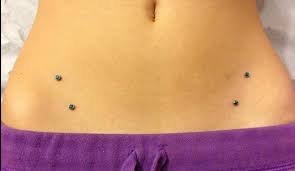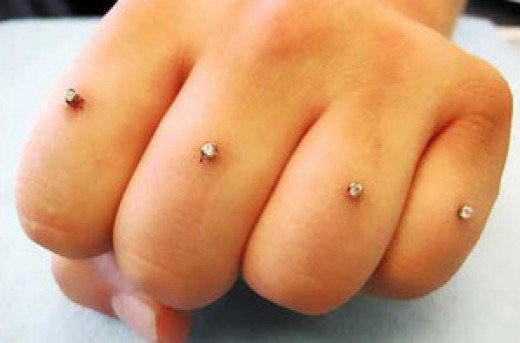What is Dermal Piercing?
Dermal Piercing Is Unlike other ordinary piercings, dermal piercings are installed on body surfaces that are flat. In this type of piercing, one end of the ornament gets embedded in the dermal skin layer while the other emerges on the surface. They are also referred to as micro dermal or single point piercings.
Dermal piercings look like small beads that are on the skin surface. Piercing can be done on different body locations;
- Hips
- Chest
- Back
- Neck
- Wrist
- Fingers
- Face
- Under the eyes
One advantage with this kind of piercing is that it can be installed on any flat surface within the body’s. This means that people can have decorations on the body areas that tend to be difficult to pierce using the regular piercings. You can make patterns on your body with multiple dermal piercings. In addition to that, you can use dermal piercings to attach an ornament right to the finger to make a dermal ring. 5

Dermal Piercing Jewelry
For purposes of reducing irritation any kind of rejection associated with the piercing, hypoallergenic jewelry is recommended. Metals in the jewelry include; stainless steel, titanium and niobium. Titanium is considered the best as it is unlikely to cause irritations.
Way of Doing Dermal Piercing
This type of piercing can either be done using a needle or a dermal punch.
Needle
The needle is first sterilized using a surgical scrub. It is then used to make an L- shaped pouch in the in the skin unlike a hole as it is normally done in other piercings.
Once the pouch has been made, a jewelry is then inserted and screwed to its base which is earlier inserted. There is a lot of expertise required and hence only a professional can perform this piercing. The needles used come in different sizes depending on the part of body being pierced and its anatomy.
Punch
Unlike in piercing with a needle where the skin is separated, using a punch involves removal of some tissue to make the pouch. This process is less painful and hence the most preferred as the cut is prevented from going deep into the skin.
Procedure
Disinfecting the piercing site
Microorganisms that can cause infection are cleansed using an antiseptic which in most cases is alcohol. Areas that have hair are clean shaven before the process.
Marking the site
Using a surgical pen, entry and exit points of the needle are perforated on the skin.
Boring the skin
A sterilized needle or punch is then inserted to the earlier made markings.
Inserting the micro dermal anchor
This is the last stage. When it is done and healing occurs, it requires a surgery to remove the piercing.

Figure 2 — Inserting a dermal piercing
What you Need to Know before you Consider a Dermal Piercing
While you can use a dermal piercing to decorate your body, there are things you may want to know so that you make an informed decision.
Unlike earlobe piercings or those piercings that are done through one side and come out on another side, with dermal piercings they are single-point having dermal anchors that are embedded underneath the skin where dermal tops screw are inserted to ensure the visible part of that dermal jewelry is sitting flat with the skin’s surface.
When doing dermal piercings, you need to know that rejection issues and potential migration may occur. Dermal piercings tend to be more prone to rejection and migration issues when compared to normal piercings. The reason for this is because with dermal piercings anchors, they may not be deeply placed under the skin.
Also, because of clothing catching the dermal top, it may result in irritations. Other issues that may lead to rejection and migration are such as infection, clothing putting pressure on your piercings, and hypergranulation.
After Care
A dermal piercing is just like a wound and needs proper care in the following ways;
- Regular cleaning of the site – a cotton soaked in a solution of salt and water should be used to clean the area. Salt is preferred over alcohol as it prevents infection and does not cause stinging.
- Washing hands before and after contact with site- this is to prevent any dirt or germs from being trapped in the piercing.
- Using mild soap during baths
- Increasing intake of foods rich in vitamin C and protein
- Avoiding frequent touching and twisting the piercing
- Exposing the site to the sun from time to time.

Figure 3 – Piercing around the eyes
Risks Involved
However cool or good they appear to be, these piercings come along with their own issues. Tissue damage is the primary risk as there are nerves and blood vessels in the dermal layer that are vulnerable especially if piercing is not properly done.
For instance, if there is deep installation of the piercing in the skin, this would lead to embedding since the skin layers will pull together. Similarly, migration is likely to occur if the piercing is too shallow. Infected dermal piercings have the following symptoms:
- Pain and swelling
- Prolonged bleeding
- Redness and inflammation
- Itchiness
- Formation and discharge of pus
- Change in skin color around the area
Crusties
These come as a result of the healing process. As the wound heals, there is normally an excretion of lymph- a substance that eventually dries up forming a whitish crust. However, this can be easily dealt with using a cotton swab by soaking it in saline and wiping on the affected area until it heals off.
Displaced dermal
This occurs when the piercing gets slightly pushed in or pulled out. It can be as a result of twisting, bumping or snagging. In this case, you should not hesitate to visit a professional immediately so that proper re-adjustment can be done.
A displaced piercing must be given tender treatment just like you would to a fresh one to allow formation of a new tissue around the region. Sea salt soaks can be used in home treating the area.
Infection
If your skin gets hot to touch or notice pus coming out of the piercing area, this means there could be chances of infection. You should make an appointment with a doctor so that necessary treatment is recommended to avoid further infection.
Hypergranulation
This is the formation of a red bump around the pierced area as a result of pressure or accumulated moisture. Frequent covering of the piercing and wearing tight garments can cause discomfort to the pierced area.
This is because there will be sweat accumulating underneath the garments and also pressure as you press against the skin. Loose clothing is therefore recommended for a while until the healing process is complete.
Scaring
They can be a result of environmental factors and occur in two forms;
Keloids
This type scaring is uncommon and mostly genetic. If a member of your family has suffered from keloids before then it is likely to occur to another. It is therefore good to know if you are prone to keloid scars and avoid dermal piercings as some worse conditions will call for dermatological surgery.
Hypertrophic scars
These mostly blend well with your skin tone when they occur. Their appearance is that of small, round and flat-topped scars. They are very common and can easily be dealt with after the piercing has healed. In most cases, jojoba oil is applied to the scars as a moisturizer while others opt for silicone scar therapy.

What to Avoid?
During the time the dermal piercings are healing, there are things that you want to avoid and they include:
Not thinning your blood
Since new piercings can bleed, you want to ensure that you don’t thin the blood during the first weeks of healing. Don’t take any medications or things that can thin the blood such as alcohol, aspirin, and excess caffeine.
Avoid bacteria and other pathogens
It may be unrealistic to avoid pathogens and other foreign material, but you should minimize these by not soaking the piercings in communal hot tubs or pools and baths.
Limit touching the dermal piercing, as this could transfer bacteria to the skin. You can use gloves whenever there is need to touch the jewelry.
Refrain from soaping the dermal piercings
You may let sudsy water to run over the piercings when showering, however, you should not directly apply soap. If in case you feel you have to apply soap to the area, let it be a fragrance-free soap. You can use sea salt solution as a cleanser during the healing process.
Don’t change the dermal tops before healing
Wait until the skin heals before you try changing the dermal tops. Also, when changing them, ensure a piercer does it. Also, it is important to know that the tissue that secures the dermal anchor will thicken with time and get reinforced.
Reference List
- Dermal piercings: Pictures, Procedure, After Care And Risks. https://tatring.com/piercing-types/Dermal-Piercing-Types-Pictures-Procedure-After-care-and-Risks
- Dermal piercing- Pictures, Jewelry, Removal, Procedure. http://healthzene.com/dermal-piercing-pictures-jewelry-removal-procedure-dangers-cost/
- Dermal Piercing Care. http://info.painfulpleasures.com/help-center/information-center/dermal-piercing-care
- Everything You Need to Know About Dermal Piercings. http://info.painfulpleasures.com/help-center/piercing-information/everything-you-need-know-about-dermal-piercings
- Infected Dermal Piercing Symptoms, Prevention And Treatment. www.geekloveshealth.com
